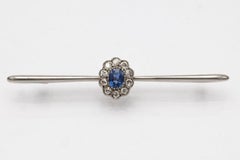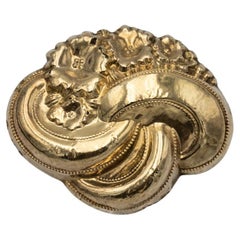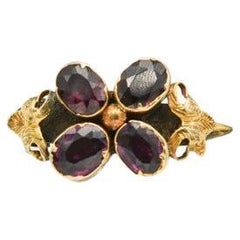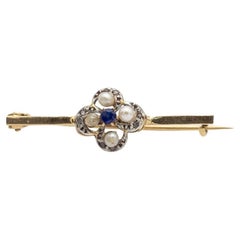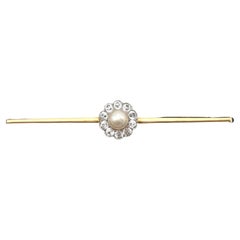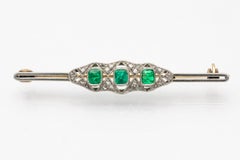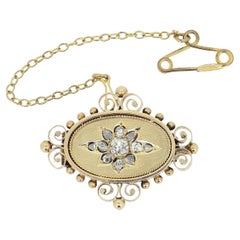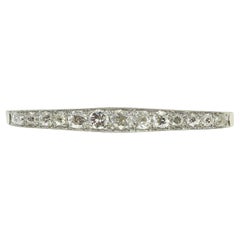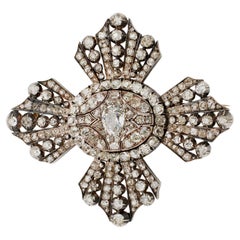Old Antique Brooches
Early 20th Century Unknown Art Deco Old Antique Brooches
Diamond, Sapphire, 15k Gold, Palladium
Late 19th Century Unknown Victorian Old Antique Brooches
Gilt Metal, Gold, 14k Gold, Silver, Copper
1910s British Victorian Old Antique Brooches
Garnet, 9k Gold
1920s French Old Antique Brooches
Diamond, Pearl, Gold, 18k Gold
Early 20th Century Swedish Old Antique Brooches
Pearl, Sapphire, Gold, 18k Gold
Early 20th Century Unknown Art Deco Old Antique Brooches
Diamond, Emerald, Gold, Platinum, 14k Gold
19th Century Victorian Old Antique Brooches
Diamond, Gold, Yellow Gold
Early 1900s Edwardian Old Antique Brooches
Diamond, Platinum
Late 19th Century Victorian Old Antique Brooches
Diamond, Gold, Silver
Early 20th Century Old Antique Brooches
Diamond, Platinum
1880s Victorian Old Antique Brooches
Diamond, White Diamond, Gold, 18k Gold, Silver
Late 19th Century English Victorian Old Antique Brooches
Diamond, Gold, Silver
Early 20th Century Victorian Old Antique Brooches
Diamond, Pearl, Gold, 18k Gold
Late 19th Century Edwardian Old Antique Brooches
Diamond, Platinum
1920s Art Deco Old Antique Brooches
Diamond, Platinum
1880s Old Antique Brooches
Diamond, 14k Gold
Early 1900s Old Antique Brooches
Diamond, 14k Gold
Early 20th Century Art Deco Old Antique Brooches
Diamond, Platinum
Early 1900s Classical Roman Old Antique Brooches
Diamond, Platinum
Late 19th Century Early Victorian Old Antique Brooches
Diamond
Late 19th Century Old Antique Brooches
Diamond, 18k Gold, Platinum
1830s Unknown Georgian Old Antique Brooches
Diamond
Early 20th Century Edwardian Old Antique Brooches
Diamond, Platinum
Early 1900s Unknown Victorian Old Antique Brooches
Diamond, Yellow Gold, Silver
1890s English Victorian Old Antique Brooches
Diamond, Natural Pearl, Pearl, 18k Gold, Yellow Gold, Silver
Late 19th Century Edwardian Old Antique Brooches
Diamond, Platinum
1920s Unknown Art Deco Old Antique Brooches
Diamond, White Diamond, Platinum
Late 19th Century Unknown Victorian Old Antique Brooches
Diamond, Gold, 10k Gold, Yellow Gold, Silver, Copper, Mixed Metal
1880s Russian Old Antique Brooches
Diamond, 14k Gold
1920s Art Deco Old Antique Brooches
Diamond, Sapphire, Platinum
Early 19th Century English Old Antique Brooches
White Diamond, 18k Gold, Silver
1910s Italian Art Deco Old Antique Brooches
Diamond, Platinum
1890s British Victorian Old Antique Brooches
Diamond, Natural Pearl, Gold, Silver
Early 20th Century European Art Deco Old Antique Brooches
Diamond, Platinum
1860s European Victorian Old Antique Brooches
Diamond, 18k Gold, Silver
1920s Unknown Art Deco Old Antique Brooches
Diamond, Platinum
1910s Edwardian Old Antique Brooches
Diamond, 18k Gold, Platinum
Early 20th Century Edwardian Old Antique Brooches
Diamond, 14k Gold, Yellow Gold, Platinum
Early 20th Century Unknown Art Deco Old Antique Brooches
Diamond, Emerald, Natural Pearl, 18k Gold
Early 1900s German Edwardian Old Antique Brooches
Diamond, White Diamond, 15k Gold, Silver
1920s Art Deco Old Antique Brooches
Diamond, Platinum
Late 19th Century British Victorian Old Antique Brooches
Diamond, Silver
1910s Edwardian Old Antique Brooches
Diamond, 18k Gold, Platinum
Early 20th Century Art Deco Old Antique Brooches
Diamond, Pearl, Platinum
Early 20th Century Unknown Art Deco Old Antique Brooches
Diamond, Opal, Platinum, White Gold
1890s American Victorian Old Antique Brooches
Diamond, Pearl, 14k Gold
Early 20th Century Old Antique Brooches
Diamond, Platinum
1880s Victorian Old Antique Brooches
Diamond, White Diamond, Gold, 18k Gold, Silver
Late 17th Century Art Deco Old Antique Brooches
Diamond, Onyx, 18k Gold, White Gold
Early 20th Century Old Antique Brooches
Diamond, 14k Gold, Yellow Gold, Platinum
1870s European Victorian Old Antique Brooches
Diamond, 10k Gold
Early 1900s Unknown Edwardian Old Antique Brooches
Diamond, Gold
Early 20th Century European Art Deco Old Antique Brooches
Diamond, Sapphire, Platinum
Early 1900s Edwardian Old Antique Brooches
Diamond, 18k Gold, Platinum
Early 1900s French Victorian Old Antique Brooches
Diamond, 14k Gold, Yellow Gold, Silver
1910s Dutch Art Nouveau Old Antique Brooches
Diamond, Gold, 18k Gold, Platinum
1910s Unknown Edwardian Old Antique Brooches
Diamond, Pearl, 14k Gold
Early 20th Century Unknown Edwardian Old Antique Brooches
Diamond, 14k Gold, Silver
- 1
- ...
Old Antique Brooches For Sale on 1stDibs
How Much are Old Antique Brooches?
The Legacy of Diamond in Jewelry Design
Antique diamond rings, diamond tiaras and dazzling vintage diamond earrings are on the wish lists of every lover of fine jewelry. And diamonds and diamond jewelry are primarily associated with storybook engagements and red-carpet grand entrances — indeed, this ultra-cherished gemstone has a dramatic history on its hands.
From “A Diamond Is Forever” to “Diamonds Are a Girl’s Best Friend,” pop culture has ingrained in our minds that diamonds are the most desired, the most lasting and the most valuable gemstone. But what makes the diamond so special? Each stone — whether it’s rubies, sapphires or another stone — is unique and important in its own right. April babies might claim diamonds for themselves, but just about everyone wants this kind of sparkle in their lives!
There are several factors that set diamonds apart from other stones, and these points are important to our gem education.
Diamonds are minerals. They are made up of almost entirely of carbon (carbon comprises 99.95 percent; the remainder consists of various trace elements). Diamonds are the hardest gemstones, ranking number 10 on the Mohs Hardness Scale. Even its name, diamond, is rooted in the Greek adamas, or unconquerable. The only object that can scratch a diamond is another diamond. Diamonds are formed deep within the earth at very high temperatures (1,652–2,372 degrees Fahrenheit at depths between 90 and 120 miles beneath the earth’s surface) and are carried up by volcanic activity. Diamonds are quite rare, according to the Gemological Institute of America, and only 30 percent of all the diamonds mined in the world are gem quality.
In the 1950s, the Gemological Institute of America developed the 4Cs grading system to classify diamonds: clarity, color, cut and carat weight. Not all diamonds are created equal (there are diamonds, and then there are diamonds). The value of the diamond depends on the clarity (flawless diamonds are very rare but a diamond's value decreases if there are many blemishes or inclusions), color (the less color the higher the grade), cut (how the diamond’s facets catch the light, certain cuts of diamonds show off the stone better than others) and carat weight (the bigger, the better).
When you start shopping for a diamond engagement ring, always prioritize the cut, which plays the largest role in the diamond's beauty (taking the time to clean your diamond ring at least every six months or so plays a role in maintaining said beauty). And on 1stDibs, a range of buying guides can be found for those in the market for antique engagement rings, vintage engagement rings or Art Deco engagement rings.
Shop antique and vintage diamond rings, diamond necklaces and other extraordinary diamond jewelry on 1stDibs.
Finding the Right Brooches for You
Vintage brooches, which refer to decorative jewelry traditionally pinned to garments and used to fasten pieces of clothing together where needed, have seen increasing popularity in recent years.
While jewelry trends come and go, brooches are indeed back on the radar thanks to fashion houses like Gucci, Versace, Dior and Saint Laurent, all of which feature fun pinnable designs in their current collections. Whether a dazzlingly naturalistic Art Nouveau dragonfly, a whimsical David Webb animal, a gem-studded bloom or a streamlined abstract design, these jewels add color and sparkle to your look and a spring to your step.
Given their long history, brooches have expectedly taken on a variety of different shapes and forms over time, with jewelers turning to assorted methods of ornamentation for these accessories, including enameling and the integration of pearls and gemstones. Cameo brooches that originated during the Victorian age are characterized by a shell carved in raised relief that feature portraits of a woman’s profile, while 19th-century micromosaic brooches, comprising innumerable individually placed glass fragments, sometimes feature miniature depictions of a pastoral scene in daily Roman life.
At one time, brooches were symbols of wealth, made primarily from the finest metals and showcasing exquisite precious gemstones. Today, these jewels are inclusive and universal, and you don’t have to travel very far to find an admirer of brooches. They can be richly geometric in form, such as the ornate diamond pins dating from the Art Deco era, or designer-specific, such as the celebrated naturalistic works created by Tiffany & Co., the milk glass and gold confections crafted by Trifari or handmade vintage Chanel brooches of silk or laminated sheer fabric. Chanel, of course, has never abandoned this style, producing gorgeously baroque CC examples since the 1980s.
Brooches are versatile and adaptable. These decorative accessories can be worn in your hair, on hats, scarves and on the lower point of V-neck clothing. Pin a dazzling brooch to the lapel of your blazer-and-tee combo or add a cluster of smaller pins to your overcoat. And while brooches have their place in “mourning jewelry,” in that a mourning brooch is representative of your connection to a lost loved one, they’re widely seen as romantic and symbolic of love, so much so that a hardcore brooch enthusiast might advocate for brooches to be worn over the heart.
Today, find a wide variety of antique and vintage brooches for sale on 1stDibs, including gold brooches, sapphire brooches and more.
- What are old brooches made of?1 Answer1stDibs ExpertFebruary 13, 2023Old brooches may be made of a variety of materials. Silver and gold are the most commonly used, but some may be fashioned out of brass, nickel and other metals. On 1stDibs, shop a collection of vintage and modern brooches.
- 1stDibs ExpertOctober 24, 2024To tell how old your brooch is, flip it over and examine the back, searching for markings. You can use these markings to learn more about your brooch and get a rough idea of its age. Depending on where and when the maker produced the piece, you may find metal purity, assay marks, serial numbers, date codes or maker's markings. When present, maker's markings are a great starting point for your research. By comparing the marking to reference guides available on trusted online resources, you can typically use it to identify the maker. From there, you can educate yourself on when the maker was in business and review guides on how to date its pieces using makings and other characteristics. Serial numbers, date codes, assay marks and purity marks may also be researched to uncover information about your brooch. If you don't find any marks at all, your brooch is possibly an antique, as most European countries have required marks for centuries, and the U.S. began mandating various marks in 1918. If you run into any difficulty while performing your research, a certified appraiser or knowledgeable jeweler can assist you with the dating process. Shop a large collection of brooches on 1stDibs.
- 1stDibs ExpertApril 5, 2022To tell how old a cameo brooch is for certain, you usually need to consult a licensed jewelry appraiser. This is because many authentic pieces do not have marks, and there are many modern reproductions that resemble the antique jewelry. Find a selection of expertly vetted antique cameo brooches on 1stDibs.
- 1stDibs ExpertApril 5, 2022Opinions on how old a rug has to be to be considered antique vary. However, most experts will apply the label to any rug produced more than 100 years ago, and call floor coverings produced 50 to 100 years ago vintage. Shop a variety of antique rugs on 1stDibs.
- 1stDibs ExpertOctober 24, 2024To tell how old an antique chair is, you have a few options. One is to conduct research on your own using trusted online resources and print references from your local library. If your chair has a maker's mark, learning more about the company, artisan or workshop that produced it can be a good starting point. Dating unmarked chairs can be more difficult because certain styles remained in production for long periods. In this case, you may wish to have a certified appraiser or knowledgeable antique dealer evaluate your chair for you. Shop a wide range of antique chairs on 1stDibs.
- 1stDibs ExpertNovember 20, 2024To tell how old an antique ring is, you have two main options. First, you can conduct online research using trusted sources. If you know the maker of the ring or the ring has a maker's mark that you can use to identify who produced it, learning more about the designer, artisan or company and their styles can help with the dating process. When the maker is unknown, you can familiarize yourself with the characteristics of various antique jewelry styles, such as Georgian, Victorian and Edwardian, to try and identify the period in which your ring was likely produced. The second option is to have a certified appraiser, experienced antique dealer or knowledgeable jeweler date your ring for you. On 1stDibs, shop a large selection of antique rings.
- 1stDibs ExpertNovember 13, 2024How old furniture that is called antique can be is typically at least 100 years. People usually call furniture between 20 and 99 years old vintage. Contemporary is the word for furniture manufactured within the last 20 years. On 1stDibs, shop a large selection of antique, vintage and contemporary furniture from some of the world's top sellers.
- 1stDibs ExpertAugust 29, 2024To tell how old your antique furniture is, research the maker using trusted online resources. You may find that the furniture maker was active for only a short period, giving you the ability to roughly estimate its age. For manufacturers and designers with a long history of production, consider the style of your furniture and look for images of similar pieces published online. Because it may be difficult to date furniture on your own, consider consulting a certified appraiser or knowledgeable antique dealer. On 1stDibs, explore a variety of antique furniture.
- 1stDibs ExpertMay 14, 2024To be considered antique, furniture must usually be at least 100 years old. Contemporary is the name for furniture produced within the last 20 years. Vintage furniture is at least 20 years old. On 1stDibs, shop a diverse assortment of antique, vintage and contemporary furniture from some of the world's top sellers.
- 1stDibs ExpertSeptember 16, 2024Yes, some old antique clocks may be worth something. Many collectors look for clocks produced by certain manufacturers, such as the Ansonia Clock Company, the Seth Thomas Clock Company, Jaeger-LeCoultre and the Chelsea Clock Company. In addition to the maker, the type, materials, style and condition of the clock influence its value. Generally, clocks that remain in good working order are worth more than those in need of repairs and restorations. To find out how much your clock may be worth, consult a certified appraiser or experienced antique dealer. On 1stDibs, explore a large collection of antique clocks.
Read More
This David Webb Coral Flower Brooch Is Better Than a Bouquet
For starters, it is one of the jewelry designer’s most celebrated works.
This Gem-Encrusted Boucheron Brooch Is a Symbol of Mid-Century Glamour and Clever Design
Though it sparkles with more than 27 carats of diamonds, this multifaceted gem delivers more than just dazzle.
The Editor of ‘Town & Country’ Loves Jewelry and History in Equal Measure
Stellene Volandes takes us on a glittering, engrossing tour through the centuries.
5 Fresh Jewelry Trends That Will Bring You Joy This Spring
From cameos to cigar bands, here are the looks on our radar this season.
Tastemaker Bunny Mellon’s Extraordinary Schlumberger Jewels
The philanthropist and heiress was an avid jewelry collector, and her trove of Jean Schlumberger creations embodies the love of nature she shared with the famed designer.
